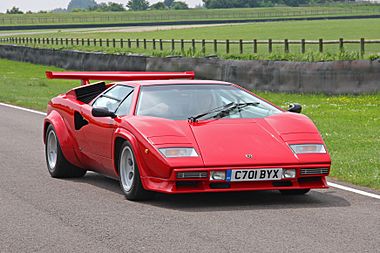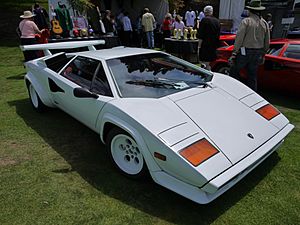Lamborghini Countach facts for kids
Quick facts for kids Lamborghini Countach |
|
|---|---|

Lamborghini Countach LP5000 QV
|
|
| Overview | |
| Manufacturer | Lamborghini |
| Production | 1974–1990 (1,983 produced) |
| Assembly | Italy: Sant'Agata Bolognese |
| Designer | Marcello Gandini at Bertone (LP500 prototype) |
| Body and chassis | |
| Class | Sports car (S) |
| Body style | 2-door coupé |
| Layout | Longitudinal rear mid-engine, rear-wheel-drive |
| Related | Lamborghini LM002 |
| Powertrain | |
| Engine | Lamborghini V12 LP400, LP400 S: 3,929 cc (3.9 L) |
The Lamborghini Countach is a super cool sports car built by Lamborghini. It was made from 1974 to 1990. The Countach came after another famous Lamborghini car, the Miura. The car was designed by a company called Gruppo Bertone. Over the years, the Countach used several different V12 engines.
Contents
History of the Countach
Lamborghini first showed the Countach to the public at a big car show in Geneva in 1971. Back then, it was known as the Lamborghini LP500. The Countach started being made in 1974. The very first model was called the Countach LP400.
Different Models of the Countach
Lamborghini made several different Countach models between 1974 and 1990. Each one had its own special features.
The LP400 Model
The LP400 was the first Countach model. Lamborghini started making it in 1974. This car had a 3,929 cc (3.9 L) V12 engine. This engine was similar to the one used in the Miura. In the LP400, it made 276 kW (375 PS; 370 hp) of power. By the end of 1977, Lamborghini had built 158 Countach LP400s.
The LP400 S Model
Lamborghini started making the Countach LP400 S in 1978. This model took the place of the LP400. The LP400 S's engine was a little less powerful than the LP400's. It made 261 kW (355 PS; 350 hp) of power. Some changes were made to the outside of the car. These included wider fender flares and a cool rear wing. These changes stayed on the Countach until Lamborghini stopped making it in 1990.
The LP500 S and LP5000 QV Models
Lamborghini made the Countach LP500 S in 1982. The LP500 S had a bigger (4,754 cc (4.8 L)) V12 engine than the LP400 and LP400 S. Lamborghini built 321 Countach LP500 S cars.
The Countach LP5000 QV was made by Lamborghini in 1985. The engine in the 5000 QV was even bigger. It was 5,167 cc (5.2 L) in size. The Countach LP5000 QV could have either a fuel injected engine or an engine with a carburetor. The fuel injected version made 309 kW (420 PS; 414 hp) of power. The carbureted version made 335 kW (455 PS; 449 hp) at 7,000 rpm. Lamborghini made 610 Countach LP5000 QVs. Only 66 of them had the fuel injection system.
The U.S. Version of the Countach
Lamborghini made a special version of the Countach for the United States. The US version had bigger impact bumpers than the European version. Many car owners took these bumpers off. This was because many people thought the bumpers made the Countach look less cool.
The 25th Anniversary Model
Lamborghini made the Countach 25th Anniversary in 1988. It got its name because Lamborghini was started in 1963, so it was their 25th birthday! Horacio Pagani designed this special Countach. It looked a bit different from the other Countach models. The 25th Anniversary model was made until 1990.
This 25th Anniversary Countach was the fastest version. It could go from 0–97 km/h (0–60 mph) in just 4.7 seconds. The car could also reach a top speed of 295 km/h (183 mph).
How the Countach's Engine Works
The table below shows the engines used in different Countach models. All Countach cars had a five-speed manual transmission. This means the driver had to shift gears themselves. The engine was placed in the middle of the car.
| Model | Engine Size | Power | Torque | Compr. ratio | Fuel System |
|---|---|---|---|---|---|
| LP500 prototype | 4,971 cc (303.3 cu in) | 328 kW (446 PS; 440 hp) | 448 N⋅m (330 lbf⋅ft) at 5,750 rpm | 10.5:1 | Carburetor |
| LP400 | 3,929 cc (239.8 cu in) | 276 kW (375 PS; 370 hp) | 361 N⋅m (266 lb⋅ft) at 5,000 rpm | 10.5:1 | Carburetor |
| LP400 S | 3,929 cc (239.8 cu in) | 261 kW (355 PS; 350 hp) | 356 N⋅m (263 lb⋅ft) at 5,000 rpm | 10.5:1 | Carburetor |
| LP500 S | 4,754 cc (290.1 cu in) | 276 kW (375 PS; 370 hp) | 418 N⋅m (308 lb⋅ft) at 4,500 rpm | 9.2:1 | Carburetor |
| LP500 Turbo S prototype | 4,754 cc (290.1 cu in) | 549 kW (746 PS; 736 hp) | 876 N⋅m (646 lb⋅ft) at 4,500 rpm | N/A | Twin turbochargers, carburetor |
| 5000 QV | 5,167 cc (315.3 cu in) | 335 kW (455 PS; 449 hp) | 500 N⋅m (369 lb⋅ft) at 5,200 rpm | 9.5:1 | 6X2 44 DCNF Weber carburetors |
| 25th Anniversary | |||||
| Evoluzione prototype | 5,167 cc (315.3 cu in) | 335 kW (455 PS; 449 hp) at 7,000 rpm | N/A | 9.5:1 | Motronic fuel injection |
How Fast Was the Countach?
The table below shows how fast the different Countach models could go. It also shows how quickly they could speed up.
| Model | Top speed | Acceleration 0–100 km/h (0-62 mph) | Dry weight |
|---|---|---|---|
| LP500 prototype | 1,130 kg (2,491 lb) | ||
| LP400 | 288 km/h (179 mph) | 5.4 s | 1,065 kg (2,348 lb) |
| LP400 S | 254 km/h (158 mph) | 5.9 s | 1,200 kg (2,646 lb) |
| LP500 S | 293 km/h (182 mph) | 5.2 s | 1,480 kg (3,263 lb) |
| 5000 QV | 298 km/h (185 mph) | 4.8 s | 1,490 kg (3,285 lb) |
| 25th Anniversary | 185 mph (298 km/h) | 4.5 s | 1,590 kg (3,505 lb) |
| Evoluzione prototype | 330 km/h (205 mph) | 4.5 s | 1,050 kg (2,315 lb) |
| LP500 Turbo S prototype | 335 km/h (208 mph) | 1,515 kg (3,340 lb) |
Images for kids
See also
 In Spanish: Lamborghini Countach para niños
In Spanish: Lamborghini Countach para niños









